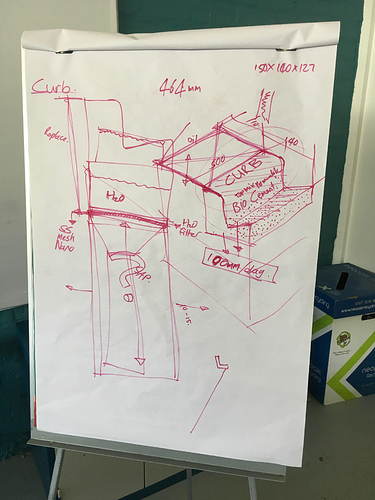Looking at possibilities of increasing the holding capacity of the water table/ground water within the western cape though using slow release material storage devices.
There is an old technology called a french drain. A pit is filled with rocks and covered over, into which storm/waste water is drained. The gaps between the rocks provide storage while the water slowly soaks into the surrounding earth.
Thanks Michael. We were thinking in that direction. Thinking about filling the drain with a perlite or silica, something organic which can absorb even more and release at a slower rate. One of the big issues are we get a substantial amount of rain in a short about of time and most run off into the sea as the ground get saturated very quickly.
This was the recent article on UCT researcher John Okedi speaking about stormwater harvesting. He talks about using upstream ponds but they have the threat is informal settlement. He advocates for bioretention cell.s
You can use porous plastic pavement made out of waste plastic. Here’s some dot points we wrote for a hackathon in our city in Australia
PPP production.docx (13.4 KB)
Thanks Cindy. There was some consideration of this. The team did an initial design that looks at retrofitting existing road networks by replacing the storm sewer intake structure with a filter column that can be inserted in place.
@Daryn_Molenaar perlite or silica would probably be too extreme, they both really hold on to water broken bricks might be better. What is needed is a sponge that slows the passage. There’s a picture on the CTSC FB page which sums it up.
More buckets is not the answer.
What about catching some of the water before it gets to the drain? http://www.diynetwork.com/how-to/outdoors/structures/how-to-install-a-rainwater-diverter-and-a-rain-barrel
We were looking into both perlite and silica and came to the same conclusion, they are too good at absorbing water. We are now looking into PVA sponge which will hold the water and slowly release it back into the ground so seep back into the water level/aquifers
@Daryn_Molenaar PVA sounds sub-optimal. “The chemical industry’s own material safety data sheets recommend keeping the substance away from food or beverages”. But it is widely used to make chewing gum 
A little factoid I picked up somewhere.
Personally I’d always go mineral or organic.
We could add place for companies to add their name if they sponsor a curb. This should be visible to the public and could help adoption rate of this kind of product instead of relying on government capital.
Hey Daryn,
I spoke briefly to the civil engineer who stopped by during the hackathon to meet the group. I asked him what his thoughts were and he thought that detention ponds would be the way to go. Probably a cost thing.
The Daily Maverick article says:
John Okedi , a PhD student at UCT says:
"I’m proposing something closer to what’s being done in Atlantis.
Can you elaborate?
As a satellite city not far from Cape Town, a key question was water supply and sewage water. Their treatment works is essentially ponds – we call them recharge cells. They bring all their waste water close to the sea. The ponds must be close to the sea because the sewage must flow by gravity towards the sea. But instead of being deposited into the sea, it is deposited into these restricted cells and actually infiltrated into the ground. They mix the waste water with the stormwater in these recharge basins. It’s a technique through which they work and then abstract it. They essentially use the ground to take out impurities."


